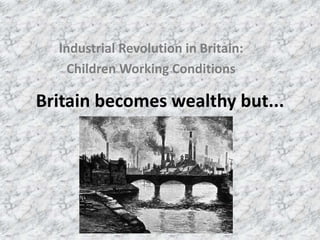
Britain becomes wealthy but
- 1. Britain becomes wealthy but... Industrial Revolution in Britain: Children Working Conditions
- 2. • Despite the growing wealth due to trade and commerce, many of the working people, who actually produced the wealth, lived, worked and died in very poor conditions.
- 3. Working conditions • Many factory owners put profit above the health and safety of their workers. Children and young women were employed in terrible conditions in textile mills and mines.
- 4. Working children • At the start of the 19th century very few children went to school. Most poor children worked. If they went to school, their families lost the money they earned. • Children were often forced to work almost as soon as they could walk. Many were used as cheap labour: a child was paid less than adults (just a few pennies for a week's work).
- 5. Why didn't children refuse to work? • Most children had no choice - they needed to work to help their families earn enough money to live.
- 6. When did children start work? • Many children started work at the age of 5, the same age as children start school today. They went to work as soon as they were big enough. • Even a tiny child could feed chickens. Older brothers and sisters took small children to work, perhaps to a factory at the end of the street. Other children worked at home, doing jobs such as washing, sewing or sticking labels on bottles.
- 7. What kind of jobs did children do? • Children worked on farms, in homes as servants, and in factories. • Children often did jobs that required small size and nimble fingers.
- 8. Chimney Sweeps • Chimney sweeping was a job children could do better than adults. The chimneys were usually very narrow (in some cases as small as 30cm) and twisted. • The work was dangerous and painful. Some boys got stuck and died of suffocation. • In 1832 the use of boys for sweeping chimneys was forbidden by law.
- 10. Factories • Children worked long hours and sometimes had to carry out some dangerous jobs working in factories. • In textile mills children were made to clean machines while the machines were kept running, and there were many accidents. Many children lost fingers and some were killed, crushed by the machines.
- 11. • In match factories children were employed to dip matches into a dangerous chemical called phosphorous. The phosphorous could cause their teeth to rot and some died from the effect of breathing it into their lungs. • The Factory Act of 1878 banned employment of children under ten years of age, but poor families needed the extra money so many children still skipped school.
- 12. Street Children • Thousands of poor children worked and lived on the streets. • They worked very long hours for very little money. To buy bread, they sold matches, firewood, buttons, flowers or polished shoes.
- 13. Coal Mines • Coal was the main source of power in Victorian times. • It was used for cooking and heating, and for driving machinery, trains and steam ships. • The coal mines were dangerous places where roofs sometimes caved in and explosions happened.
- 14. • Trappers Trappers were children who operated the air doors providing ventilation for the miners. • The children would sit in the draft of the doors, cold, damp and very frightened, with little or no light for 12 hours a day.
- 15. • Drawers Drawers pulled heavy carts of cut coal to the pits surface with heavy chains around their waists.
- 16. When did children stop working in the mines? • The Mines Act was passed by the Government in 1842 forbidding the employment of women and girls and all boys under the age of ten down mines. • Later it became illegal for a boy under 12 to work down a mine.
- 17. Why were children employed to work in factories? • Children were much cheaper than adults as a factory owner did not have to pay them as much. • There were plenty of children in orphanages, so they could be replaced easily if accidents did occur. • Children were small enough to crawl under machinery to tie up broken threads.
